After an impressive and outstanding 40+ year career at the State Cartographer’s Office, our own Brenda Hemstead will be retiring in April of 2020.
Brenda, a paramount figure not only in the SCO, but also within the Wisconsin Society of Land Surveyors, the Wisconsin County Surveyors Association, and the Wisconsin Land Information Association, began her career as a typist when the State Cartographer’s Office was its infancy. She has risen through the ranks (and many titles!) and has proved herself to be an essential member of the SCO team since day one.
The following are excerpts from an interview with Brenda in early April 2020.
The staff at the State Cartographer’s Office would like to note that with COVID- 19 concerns we have been forced to be away from Brenda as she prepares for retirement. While difficult, we plan to celebrate Brenda and all of her accomplishments sometime in the near future.
Q: So Brenda, how did you end up at SCO?
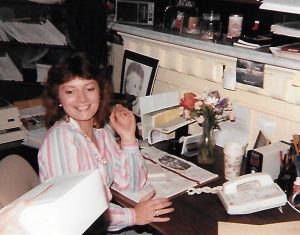
A: During my last few months of high school, I took a “State” typing test. At the time my mother, who was a long time employee at Extension Duplicating (now known as DoIT Printing Services), was encouraging me to get a job with the “State”. I ended up getting phone calls from various departments on campus for interviews (hah, just had to sit back and let them contact me). After I had my interview at the State Cartographer’s Office, I remembered I really wanted to work here for a couple of reasons. The Office was located in an old historic building, I would have my own office, the Memorial Union was across the street, and State Street was only a block away. When I got the phone call, I excitedly accepted the offer and started three days later on July 16, 1979.
Q: What were the early days at SCO like?
A: Oh boy, the early days! When I first started, I really didn’t have a clue what a cartographer was or did. I was as green as grass! The Office had only existed for five years and I believe I was the first full-time receptionist/typist. In addition to myself, there was the Assistant State Cartographer, Christine Reinhard, the State Cartographer, Art Zielger, about six student hourlies, and three project assistants. We were located on the first floor of Science Hall in the offices now occupied by the Geography Department’s administrative staff until we switched places in 2004. I was first located in Room 155 and all our students were cooped up in Room 170 with light tables. None of our offices had air conditioning… Science Hall got hot and muggy when summertime rolled around! I started out using a typewriter (non-correcting, that is) and used carbon paper to have a copy on file of the letters I typed. I can’t tell you how happy I was to get a self-correcting typewriter years later. However, if we needed to make copies of correspondence, I had to go up to the third floor to get an Auditron (to track our office copy usage) and then go up to the 4th floor where the Geography Department’s copier was located. I did this many times a day (ugh). Let me see, oh yeah, there was always a risk of being stuck in the elevator. Back then the elevator wasn’t all that reliable – several times a day it would get stuck and you’d hear the buzzer blasting from the folks inside pressing the alarm. Fortunately, I never got stuck in it. Another duty I just loved to do (NOT) was having to mix/add chemical solutions (fixer and developer) when using our VariTyper for lettering, using rub-ons for special text, and lettering for our various printed publications. It’s amazing for some of us “old timers” to look back at how things were done before computers and automation!
Q: What was it like working for Art Zeigler?
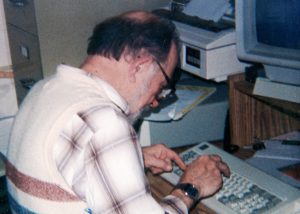
A: Art Ziegler, Art, or Mr. Z, as most of us called him, was unique in so many ways. Art was hired by Arthur H. Robinson in 1974 and was Wisconsin’s first State Cartographer. Art’s vision was to provide catalogs depicting various themes of data collected by the counties, the state, and nationally, such as: aerial photography, geodetic control, cadastral, soils, etc., to provide awareness and reduce duplication. I remember, very clearly, my first day on the job when Art came into my office and wanted to dictate a letter to me on my non-correcting typewriter. I was petrified! There he was, standing over my shoulder dictating a letter to me and watching as I typed. Art continued to do this often since it was easier for him to keep his train of thought versus writing it on paper or typing it himself. Eventually, I got pretty darn good at taking dictation from Art and marveled at how he could be so fluid, knowing when to pause for me to catch up to him, and still keep his train of thought throughout the dictation. However, when I discovered and encouraged him to use a Dictaphone for me to transcribe his letters amongst the many others tasks I was performing, it proved to be quite the challenge for him, and he didn’t like it. In a nutshell, Art was spoiled being able to dictate to me whenever he wanted even as times and technology were changing. Another notable thing about Art is that he was a good artist, but then again so were most cartographers back then. In his office, Room 160, Art drew a large wall map of Wisconsin with county outlines using rub-on lettering and pens. This wall map still exists today and is quite impressive.
Q: Who else worked at the SCO and what were they like?
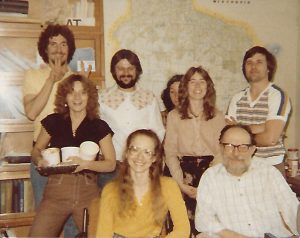
A: Like I mentioned earlier, besides Mr. Z, there was Christine Reinhard, Assistant State Cartographer. Chris was a hard worker and a bit feisty. She was, in my opinion, the backbone of the office. I felt she really had to prove herself because she was a woman in a male-dominant department. Chris left the office around 1987 to become the Washington State Cartographer, and in my opinion she did this to strengthen her resume so that when Mr. Z retired, she could fill his position. However, Chris ended up getting married and started a Tilapia fish farm in Clintonville, WI. Making a long and interesting story shorter, Chris’s husband went missing for about three years. Chris sold the farm to find him and even had the show, “Unsolved Mysteries” do a story on his disappearance. A short time later, he was found in Florida and had suffered from amnesia. However, because so much time had passed, Chris had finally given up and moved on with her life- they divorced and remained “friends”.
Bob Gurda was hired in 1988, replacing Christine as the Assistant State Cartographer. Bob had a master’s degree in Cartography from UW-Madison and came to the office from his previous position in the Department of Landscape Architecture at UW-Madison. In my opinion, Bob was a great publications writer and rather soft-spoken. It didn’t take long for me to “break Bob in” with my antics. When Mr. Z retired in 1990, Ted Koch was hired as the second State Cartographer. Ted also had a master’s degree in Cartography from UW-Madison and was employed with the New York State Department of Transportation before coming to Madison. Bob retired in 2004 and was replaced by Jim Lacy as Associate State Cartographer. Jim had returned to the SCO where he was a student Project Assistant from 1992-1994. Lastly, Ted retired in July 2009 and was replaced by Howard, coming to the SCO from Rand McNally…need I say more about Howard?
Q: Who did the office interact with in the Geography Department?
A: Well, back in the very early years, our office interacted with Prof. Arthur Robinson and Prof. Joel Morrison and then with Prof. Phil Muercke and Prof. David Woodward. We also interacted with Mary Galnedar, Map Librarian, and Onno Brouwer, Director of the Cart Lab. Then there was good ole Shirley Paley, who was the department administrator when I first started. She was all over the place, knew everybody, had many connections, and was forgetful. Her desk had papers piled high- a complete mess – but Shirley had a way of getting things done effectively. She remembered everyone’s birthday and always had a little gift to give. When she needed work done by the trades on campus, they showed up promptly, and she always rewarded them with a gift or homemade cookies/treats.
Q: What are some of your best memories of the early years?
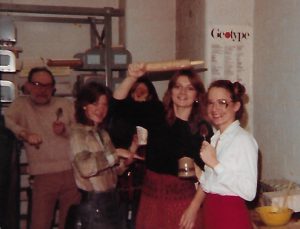
A: Oh I have many great memories, but one that really sticks out was when I mentioned to staff and students that we should make doughnuts. They’re response was, “yeah, sure thing”. So I decided to show them I wasn’t bluffing. I made the dough and frosting at home and brought it in along with a pan, oil, rolling pin, flour, and a cup. I created an assembly line in Room 144 with our students and staff who rolled out the dough and used a cup to cut out the circles. Next, they cut out the doughnut holes, then they cooked them in the oil, and finally they frosted them with vanilla and chocolate frosting. Everyone loved it and the fragrant smell of doughnuts floated throughout the building. I did this not once but twice, in 1982 and again in 1986.
Another great memory was when I pulled a couple April Fool’s Day jokes. The first one was on Ted Koch, the second State Cartographer. I wrote down a message for him to call a woman back and hid around a corner as he called. He dialed the phone number (for the zoo) and he asks to speak to Ms. Ellie Fint. After he was told that he had been pranked, I could hear him yell, “BRENDA!”. It took me quite a while to stop laughing. Of course, I had to do something similar to Howard Veregin, the third and current State Cartographer on April Fool’s Day. I bought an air horn (like one used on boats, etc.) and duct-taped it to Howard’s chair. I raised his chair so that when he sat in it he would have to lower it and when he did, the horn would sound off. Oh, it worked beautifully and I almost choked from laughing so hard (although Howard would never admit he got pranked).
Q: Can you describe your journey from Typist to Data Services Professional? The evolution is quite impressive.
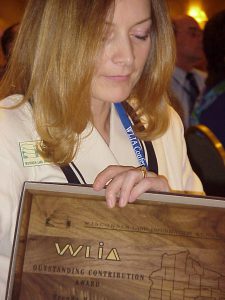
A: Oh, there isn’t enough space on the internet for this answer! My journey of progression through the UW System had many ups and downs. It was always difficult for me to obtain a suitable classification over the years largely due to our office being one-of-a-kind. Sure, when I first started as a typist, I was doing relatively basic secretarial duties and had a steep learning curve to overcome. However, after a couple of years of absorbing knowledge from the staff, auditing some mapping/cartography classes, learning the UW’s policies and procedures, and becoming more independent, I was no longer just a typist. I was slowly blossoming into a valued employee eagerly wanting to expand my knowledge about cartography, aerial photography, and geodetic control. I always had to take the initiative myself to seek a reclassification. No one would say, “Geez Brenda, let’s try to reclassify your position because your duties have changed so much”. The process for doing this through the “system” was terribly time consuming and difficult for the State Cartographer(s) to pursue.
One of those downs that I mentioned was when I was told attempting to reclassify my position wouldn’t be wise and it was implied that I could be demoted if I pursued it. However, after pursuing it, it was decided my position had evolved so much that it would fall into a higher classification given as a promotion (rather than a reclassification) warranting it to be opened up for others to apply, including myself. Being fearful, I took the reclassification which was a lower rate of pay than what the promotion would have provided. By this point, my position description entailed performing much higher level duties/skills than what my reclassified title and pay reflected – ugh! Another instance occurred years later when my then title was being abolished through attrition. This was news to me as I was never given notice prior to this enactment. Because of this, I essentially had no ladder to climb and was at a dead end. We tried, again, to reclassify my position due to the level of difficulty my duties entailed, but we were again, denied. I fought this and had to take my case to higher levels within the university. This process took a long time, but after an on-sight audit by UW-System HR, the initial denial was overturned and thus a new title, once again, was assigned to me.
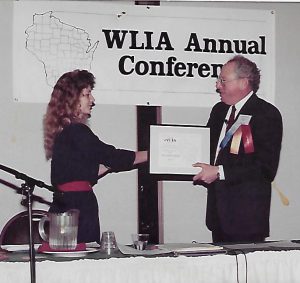
But there were a few times when my work was recognized. In 2001, I received the Outstanding Classified Staff Service award, and in 2018, I received the University Staff (formerly Classified Staff) Excellence award both given by the College of Letters and Science. Both State Cartographer’s wrote very sincere and beautiful letters nominating me, and after reading them, I had a sweet tooth from all the sugar they added!
Here is the list of titles I had throughout the years: Typist II, Technical Typist I, Program Assistant 1, Program Assistant 2, Program Assistant 4, Administrative Assistant 3, Administrative Support Assistant 1, IS-Resource Support Technician, and lastly, IS-Data Services Professional.
Q: As a woman working in fields dominated by men, were there times when you had to prove yourself more? If so, has that changed since 1979?
A: Hmmm, this is kind of a tough one to answer because I was in such a small office. However, I did feel that because I was a woman, I was perceived as the secretary long after my position had evolved out of that role. I remember once when a coworker brought his young son into the office and he asked him why I didn’t fetch his dad coffee, assuming I was his secretary. It also bothered me that I often wondered if my colleagues and contacts thought of me as just a secretary, always feeling like I had to prove I wasn’t.
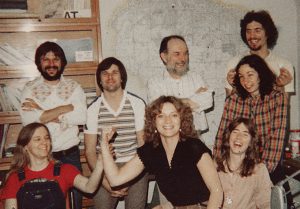
Early on, I gravitated towards the surveying community, especially the county surveyors. The surveying profession was and still is a very male dominant field, at least in Wisconsin. I found out that I needed some thick skin in order to interact with many of them. It’s unfortunate that there aren’t more women in that profession. Currently, Wisconsin has no female county surveyors. I remember once when I had to meet with a hard-nose, chauvinist professional in an effort to acquire their data. During a conversation, I ended up getting in his face and after all was said and done, he provided his data. I refused to let him bully me because I was a woman, and we got the data we needed.
Looking back, I also recall the Geography Department not having any women faculty back in my early years, something that has slowly changed over time.
Q: What’s one thing (besides yourself!) that has remained constant in SCO all these years?
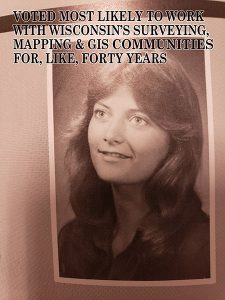
A: One thing huh? Sorry but there are a few. The mission of the SCO as being Wisconsin’s resource for information about maps, cartography, GIS/LIS, and geospatial technology hasn’t changed! This has been a steady constant over the years. Sure, the methods in which we provide these resources and services have changed and evolved but the fact we have continued to embody the “Wisconsin Idea” for over 40 years is impressive. I witnessed all three State Cartographer’s visions and methods in accomplishing our mission from paper products to computer automation to online services. Along with that, another constant has been the ability to obtain both vast amounts of knowledgeable and talented staff and student employees over the years. The large impact and productivity from our small office is truly amazing!
Did you know I, along with other staff at the SCO, provided the administrative support to the Wisconsin Land Information Association (WLIA) during its early formation? We organized conferences, maintained the membership lists, and managed the finances. As the Association grew in membership and activity, management responsibilities were contracted to others. I served on the WLIA Board of Directors for four years and several committees along with my fellow staff at the SCO. Our support and involvement in the WLIA has always been constant as well as with the Wisconsin Society of Land Surveyors and the Wisconsin County Surveyors Association.
Q: Do you have any plans for retirement?
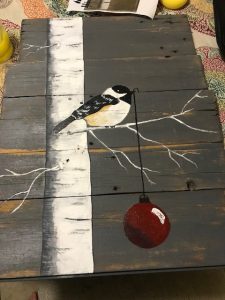
A: Well our initial plans were to do a bit of traveling, but I guess that’s no longer an option during this ugly point in time. We currently have one grandson and he will be joined with a brother or sister in September, so it will be good to be able to hike up to where they live in Green Bay whenever we feel like it. Our daughter is about a 4-hour drive south, so there’s some spontaneous road trips in the future as well.
One thing I’ve been contemplating is setting up a small booth at some of the area craft shows. I’ve always enjoyed drawing and crafting. I’ve painted on rocks, bowls, bottles, jars, wood, etc., and have made garden gizmos, pillows and blankets. I keep getting pushed by family members to “go for it”, telling me people will buy them. I’m kind of skeptical but, what the heck!
Q: Last question: you will be terribly missed in the SCO, the Geography Department, and Science Hall. What will you miss the most?
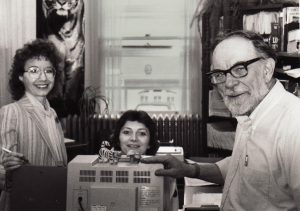
A: I know I’m going to miss the interaction with my county surveyors and my network with the surveying community, and of course, the talented and amazing staff at the SCO and associated departments. I’ve learned SO MUCH from each one of them throughout the years! Not a day went by where I didn’t learn something new. Of course, I will greatly miss all of you!
Best of luck with your retirement, Brenda!
